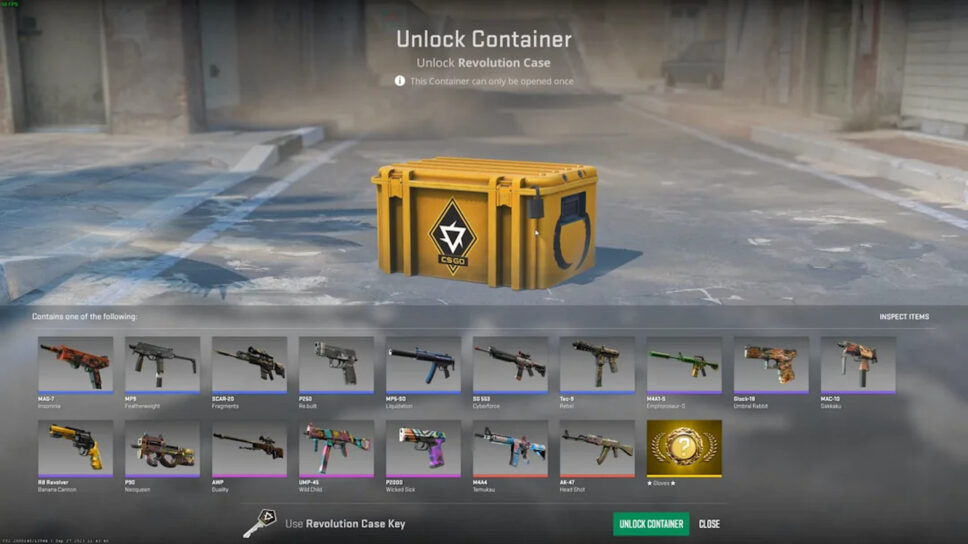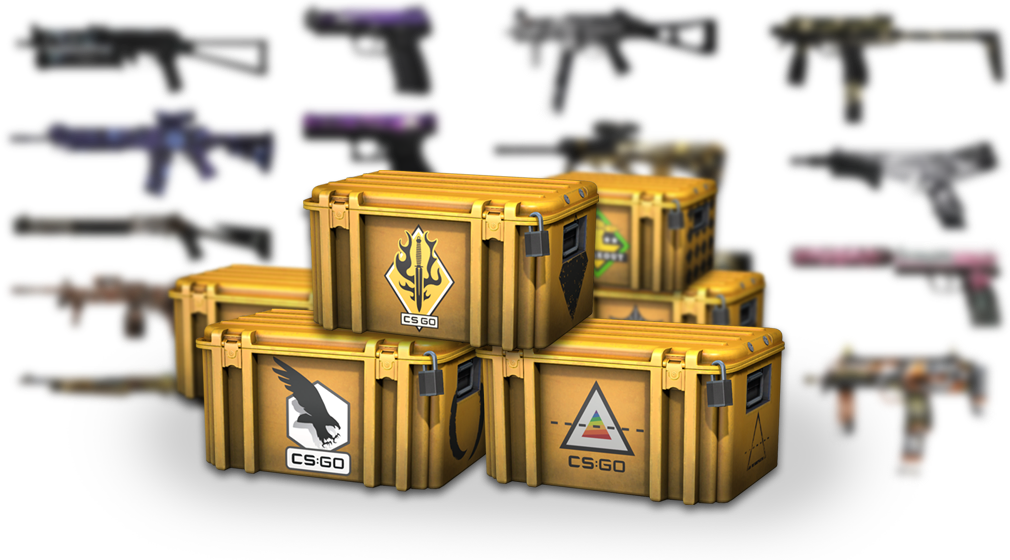You download a free-to-play game and you realize that other players’ characters have fancy weapons, clothes or animations – this is your introduction to the world of skins worth $50 Billion as of 2022 (Naysmith, 2022) and the world of gambling to obtain them posing questions about the ethics of the microtransaction business model.
Skins are non-functional in-game items, which usually do not enhance a player’s chance for victory. If these are not necessary, why buy them? Research shows that skins allow for a better representation of oneself by customizing one’s experience in a social context (Hamari et al., 2017), they are sometimes used as a means of self-gratification, as a way of showing support to the developers or showing off status and giving a sense of in-game authority among others (Marder et al., 2019). This phenomenon can be observed in many blockbuster games such as League of Legends or Counter Strike.
Counter Strike is a shooter game that earns a staggering amount of revenue from case unboxings and commission fees charged upon selling said skins on the Steam market (a gaming platform owned by CS’s developer). It made roughly $980 million in 2023 (Williams, 2024), with the most expensive skins ranging from hundreds of thousands of dollars to a million depending on the pattern, rarity and condition (Andersen, 2024). Thus, it is crucial to investigate how these skins can be obtained and the process resembles gambling. In Counter Strike, skins can be mostly obtained by opening cases with a small chance of drawing an expensive item. This fits the definition of gambling, the activity of betting money with the hope of multiplying one’s monetary input, however, Steam does not offer the possibility to withdraw the money from one’s account, hence the possible gain can only be realized in-game. Thus, the nature and profitability of gambling in Counter Strike led to the birth of third-party websites focused on opening cases and selling skins. Furthermore, case openings were banned in the Netherlands and Belgium in 2018 as a violation of the countries’ gambling laws (Chalk, 2018). Since then, the process of opening cases received a bit more clarity since the possibility of ‘dropping’ an item of a certain class is known beforehand. However, this raises questions about the ethics of microtransactions business models and what the future for them is.

Research shows that 51% of respondents reported both gambling and watching esports with the number rising to 67% if the respondent had purchased in-game loot boxes, oftentimes using the in-game skins to gamble online. There is a link between playing video games, buying in-game cases and gambling (Macey & Hamari, 2018) (Brooks & Clark, 2019). Other research shows that the majority of players view loot boxes as a form of gambling (Brooks & Clark, 2019). Many of the games that employ the microtransactions business model with a focus on nonfunctional in-game items have a fair share of the younger generation in their player base with many of them being younger than eighteen years old (Macey & Hamari, 2018), with some reports stating that 70% of Counter Strike skin gamblers started when they were under the age of eighteen (Stubbs, 2023). In Counter-Strike, even some professional players are younger than eighteen years old (HLTV). However, still in-game loot boxes are widely accepted and the business of skins is thriving.
In conclusion, there is a definite ethical problem with this business model. The activity of opening loot boxes may be harmful to the player base. In my opinion, this calls for a legislative intervention and perhaps more governments should follow in the footsteps of the Netherlands and Belgium. In addition, gaming platforms and third-party websites should be controlled more strictly, enforcing improved KYC systems from the current, almost nonexistent ones. All in all, there should be strict initiatives towards making games following the described business model a safer environment.
References
Andersen, K. (2024) Counter-strike 2 weapon skin becomes most expensive cosmetic ever at $1,000,000, Metro. Available at: https://metro.co.uk/2024/06/06/counter-strike-2-skin-expensive-cosmetic-ever-1-000-000-20982532/ (Accessed: 17 September 2024).
Brooks, G.A. and Clark, L. (2019) ‘Associations between loot box use, problematic gaming and gambling, and gambling-related cognitions’, Addictive Behaviors, 96, pp. 26–34. doi:10.1016/j.addbeh.2019.04.009.
Chalk, A. (2018) CS:GO Players in Belgium and the Netherlands can no longer open loot cases, pcgamer. Available at: https://www.pcgamer.com/csgo-players-in-belgium-and-the-netherlands-can-no-longer-open-loot-cases/ (Accessed: 18 September 2024).
Hamari, J. et al. (2017) ‘Why do players buy in-game content? an empirical study on concrete purchase motivations’, Computers in Human Behavior, 68, pp. 538–546. doi:10.1016/j.chb.2016.11.045.
HLTV (no date) Danil ‘Donk’ kryshkovets’s counter-strike player profile | hltv.org, HLTV. Available at: https://www.hltv.org/player/21167/donk (Accessed: 17 September 2024).
Macey, J. and Hamari, J. (2018) ‘Esports, skins and loot boxes: Participants, practices and problematic behaviour associated with emergent forms of gambling’, New Media & Society, 21(1), pp. 20–41. doi:10.1177/1461444818786216.
Marder, B. et al. (2019) ‘The avatar’s new clothes: Understanding why players purchase non-functional items in free-to-play games’, Computers in Human Behavior, 91, pp. 72–83. doi:10.1016/j.chb.2018.09.006.
Naysmith, C. (2022) Gaming skins just became a $50 billion industry, Yahoo! Finance. Available at: https://finance.yahoo.com/news/gaming-skins-just-became-50-143352555.html?guce_referrer=aHR0cHM6Ly93d3cuZ29vZ2xlLmNvbS8&guce_referrer_sig=AQAAAGRh6vEYA0LjkWXwjuuVxZmtz34KRFmzO4mC8_nXajD3aiD77524JsoNEMMPlW9AUNC3vytNP9n2quJpmvyQxbhPBpoW1bh0r5VV2BltYoSXupXQqnsY3-6k6Bbswed32OMyq-kl3Sfb8rJ04Tf7z_OA_OceDWtFbspiXWH5KtyZ&guccounter=2 (Accessed: 17 September 2024).
Stubbs, M. (2023) 70% of ‘cs:GO’ gamblers started as minors according to YouTuber Report, Forbes. Available at: https://www.forbes.com/sites/mikestubbs/2023/07/25/70-of-csgo-gamblers-started-as-minors-according-to-youtuber-report/ (Accessed: 18 September 2024).
Williams, K. (2024) Here’s how much money did valve make from CS2 in 2023, Counter Strike 2. Available at: https://esports.gg/news/counter-strike-2/valve-cs2-money-2023/ (Accessed: 18 September 2024).
Image sources:
Thumbnail: https://www.counter-strike.net/workshop/workshopstyleguide
Article: https://esports.gg/guides/counter-strike-2/how-to-get-cases-in-cs2-everything-about-skins/


Hi Jakub, I found your article really interesting and well written. I already know the CSGO skin market but I would like to follow up what you wrote by saying that the main reason why there is a lot of gabling amongst young people is because it is not in-game purchases, but they built a whole external market with steam around it. That is why regulations are really difficult to implement since it changes really fast. We can think of external and intependant websites that use steam bots to transfer your valuable skins into the website such as Bitskins or Buff market. a lot of money was being made but in 2019 (i belive), Steam introduced a 7 day tradeban on all arriving iteams in one’s steam account. That means that if you wanted to gamble your skins, the transfer process made it much more difficult.
These regulatory changed are not as fast as the csgo skin fanbase, they will always find loopholes to continue to trade and to gamble. Now, you can sell a skin on an external website and sell it before the 7 day tradeban and buy skins that are on the website for longer than 7 days. Therefore overcoming this regulation. Regarding the minors trading skins and gambling skins, Think about how difficult to regulate that when it is ever changing with new websites every months. The demand is just too high that the regulatory people cannot catch up unlsess they make drastic changes. But, as you said, the market cap is huge, a lot of people make a living out of it.
Hey Eli, thank you for your comment! I completely agree with your point and indeed this is for sure a valid perspective as I agree it is super difficult to block out something that is so profitable. However, I still believe that at least some attempts at it have to be made. In my mind, Steam’s introduction of the 7-day trade ban was not made out of goodwill but to encourage users to keep using the Steam market, therefore, fighting back for the gains lost to the third-party websites. Still, as you say it is incredibly difficult to regulate something that is changing so rapidly.